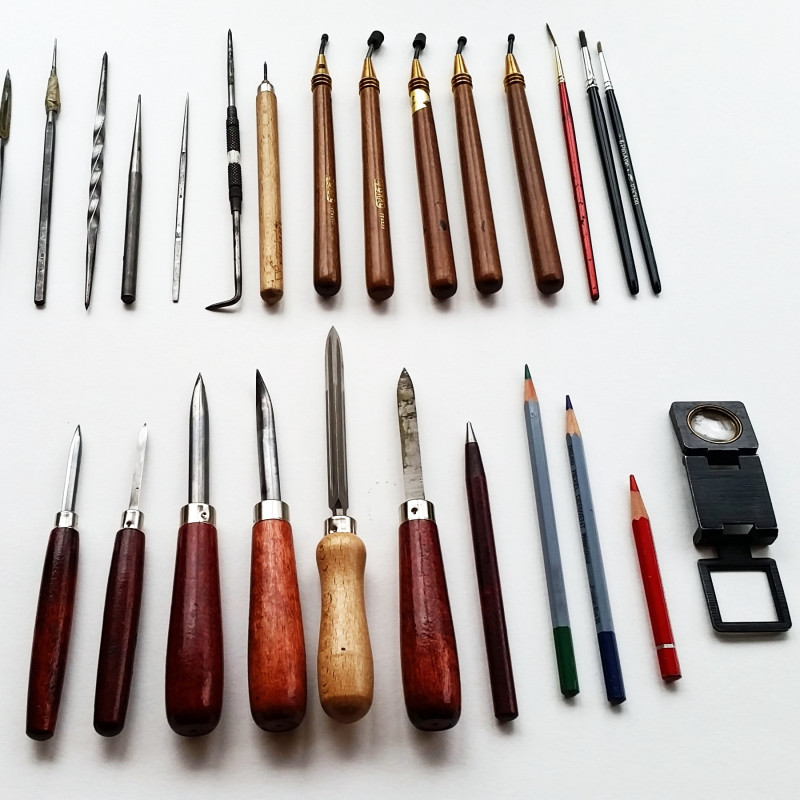GLOSSARY OF OTHER TERMS
BURIN (or Graver): an engraving tool made from a square- or lozenge-shaped steel rod with one end set in a wooden handle and the other sharpened at an angle so that one corner protrudes as a cutting edge, used both for copper plate intaglio and end-grain relief engraving.
ROLLER/BRAYER: tool used to roll out ink onto ink slab and block; can also be used for printing.
BURR: the process of incising the plate for a drypoint print creates a slightly raised ragged rough edge to the lines, known as the burr.
When ink is applied to the plate for printing, it sits within the incised line and is also held within the burr, giving the printed line a distinctive velvety character.
HARD GROUND: usually refers to a solid substance made into a ball from a mixture of wax, resin and bitumen that is laid uniformly, as a covering impervious to acid, upon the surface of an intaglio plate.
When heated enough to melt, the ground may be spread evenly with a roller or dabber. When cooled, the ground adheres to the metal plate without coming off except where a design is scratched into it, with a sharp metal needle, to expose the metal that is to be etched with a mordant. A liquefied version of hard ground is a suspension in chloroform or ether that can be poured over the plate at room temperature, as a protective coating, and similarly worked after the vapours have evaporated.
SOFT GROUND: a greasy, slightly sticky substance is made with portions of wax, resin and bitumen with tallow added so that it does not become entirely solid. When laid on a warmed intaglio plate, it adheres enough to form a thin protective coating but will lift off wherever it is touched. A design is usually created by laying a piece of paper onto the plate onto which soft ground has been freshly applied; the artist then draws onto the paper with pencil or another sharp-tipped tool so that, when lifted off, the paper lifts off ground from the plate in relation to where the pencil marks have been made. When the plate is etched, the acid will attack the areas of exposed metal, creating a textured design with an appearance somewhat similar to an aquatint or a soft crayon mark.
CHINE COLLÉ: roughly translates from French as 'chine' = tissue and 'collé' = glued. It is a technique in which a thinner piece (or pieces) of paper is/are glued to a thicker piece, often during the printing process, and used to create different tones or apparent layers in the print via the different tones or colours of the papers used.
OFFSET LITHOGRAPHY: offset printing presses were developed early in the 20th century. They can precisely register colour and can print from photo-mechanically originated material. In older print processes, the printed image is the reverse of the image on block/stone/plate, so the artist must create the image back-to- front. Offset removes this difficulty as a rubber roller picks up the ink from the plate before transferring the image the right way round onto paper.
OFFEST PRINTING: method of transferring a still-wet print from one surface to another.
REDUCTION METHOD: process of making a multi-colour (or tonally graded) print from one block. The wood, lino or card block is cut and printed in stages, each stage overprinted on top of the preceding printing. Between each printing, further cutting is carried out - thereby gradually reducing the block's uncut surface.
MULTIPLE-BLOCK PRINTING: method using more than one block to produce an image - usually in several colours.
With thanks to Anne Desmet RA RE for her printmaking definitions.
